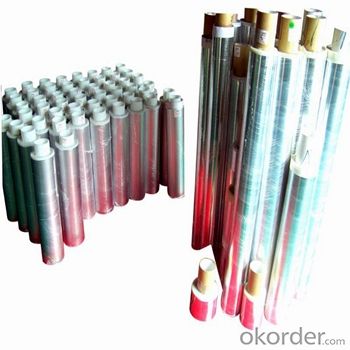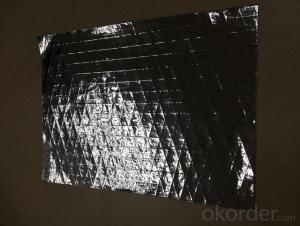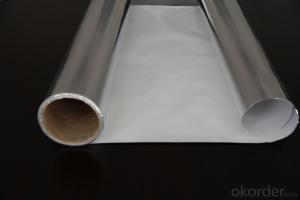Aluminum Foil Facing Colorful Mylar Insulation Roofing Aluminum Foil
- Loading Port:
- Shanghai
- Payment Terms:
- TT OR LC
- Min Order Qty:
- 300 lb/ft
- Supply Capability:
- 50000000 lb/ft/month
OKorder Service Pledge
OKorder Financial Service
You Might Also Like
1. Aluminum Foil Mylar Insulation Description:
1. Low cost, professional production process
2. New and good quality basic material of aluminum foil and polyester film
3. Act well as electronical and EMC shielding and insulation
4. Wide range of application and easy to use
5. RoHS and CTI standard
2.Main Features of the Aluminum foil Mylar Insulation:
• Light weight
• High manufacturing accuracy
• High strength
• Small inertia resistance
• Strong heat dissipation ability
• Good visual effect
• High reflective insulation
• Heat resistant, water proof, stable at high temperature;
• environmentally friendly,no smell and not-toxic;
• Smooth and clear surface;
3.Aluminum Foil Mylar Images



4.Aluminum Foil Mylar Specification
TYPICAL PHYSICAL PROPERTIES:
PROPERTIES | UNIT | VALUE | TEST METHOD |
Basic weight | gsm | 180 | ASTM D646 |
Tensile strength: M. D. X. D. | N/25mm | 195 150 | ASTM C1136 |
Burst strength | N | 125 | ASTM D774 |
Reflectivity of foil surface | % | 195 | ---------- |
Temp. Resistance | -29°C +66°C | No change keep soft | ASTM C1263 |
Water vapor permeance | ng/N.s | 11.15 | ASTM E-96 |
Water Soak Test | 24hrs | No delamination | ---------- |
Width: 1.0m, 1.2m, 1.25 m, 1.30, 1.37m
Length: 200m, 500m, 1000m, 2500m, 2750m, 3300m
Core I.D.: 3"(76mm ±1), 72mm ±1
Based on order, special sizes are also available.
5.FAQ
We have organized several common questions for our clients,may help you sincerely:
(1)What is the storage condition?
The products should be stored at room temperature and kept from wet and heat source.
It is essential, as with all pressure-sensitive tapes, that the surface to which the tape is applied must be clean, dry, and free of grease and oil.
The user should take test and do trial-application on the above products before coming into application so as to witness and ensure suitability for user’s special purpose and technique.
(2) How to guarantee the quality of the products?
We have established the international advanced quality management system,every link from raw material to final product we have strict quality test;We resolutely put an end to unqualified products flowing into the market. At the same time, we will provide necessary follow-up service assurance.
- Q: Is it possible to replace plastic wrap with aluminum foil for food storage or packaging purposes?
- <p>While aluminum foil facing can be used in some instances for food storage or packaging, it is not a direct substitute for plastic wrap. Aluminum foil is more durable and heat resistant, making it suitable for covering dishes or wrapping food for cooking or freezing. However, it is not as clingy or airtight as plastic wrap, which can be crucial for preserving freshness and preventing cross-contamination. Additionally, aluminum foil is not microwave-safe, unlike plastic wrap, which can limit its use in certain food storage applications. For best results, use the appropriate material based on the specific needs of food storage or packaging.</p>
- Q: What are the safety regulations or guidelines that aluminum foil facing must adhere to?
- <p>Safety standards for aluminum foil facing are crucial to ensure the product's safety and effectiveness. These standards typically include requirements for material composition, thickness, and bonding strength to ensure the foil's durability and resistance to tearing. Additionally, there are guidelines for the foil's reflectivity and heat resistance, which are important for its performance in various applications. Compliance with these standards is often verified through testing and certification processes, ensuring that aluminum foil facing products meet the necessary quality and safety benchmarks before they reach the market.</p>
- Q: Is it safe and effective to use aluminum foil with a reflective side for baking purposes?
- <p>Yes, aluminum foil facing can be used for baking. The shiny side of aluminum foil is often used to cover baking dishes to prevent food from drying out, to create a steam effect, or to reflect heat for even cooking. However, it's important to avoid direct contact between the foil and the heating elements of the oven to prevent fire hazards. Always follow the manufacturer's guidelines for safe use and placement of aluminum foil in your oven.</p>
- Q: What are the potential health advantages of using food packaging that does not contain aluminum?
- <p>Yes, there are health benefits associated with using aluminum-free food packaging. Aluminum has been linked to potential health risks, including Alzheimer's disease and neurological disorders. By avoiding aluminum in food packaging, there's a reduced risk of exposure to this metal, which can leach into food, especially when heated. This can help minimize the intake of aluminum, potentially lowering the risk of related health issues. Aluminum-free packaging also reduces the environmental impact and is often more sustainable, contributing to overall health by promoting a cleaner environment.</p>
- Q: Is it possible to use aluminum foil with a reflective side to line a cake tin for baking purposes?
- <p>Yes, you can use aluminum foil facing to line a cake tin before baking. It helps in creating a smooth finish on the cake and can prevent sticking. However, ensure the foil is food-grade and does not have any sharp edges that could tear or puncture the cake. It's also important to grease the foil lightly to facilitate easy removal of the cake after baking.</p>
- Q: Is it safe to use recycled aluminum foil as a facing material in cooking?
- <p>No, it is not recommended to use recycled aluminum foil for cooking. Recycled aluminum foil may contain impurities, contaminants, or have been exposed to chemicals that could be harmful when heated. Additionally, the quality and safety of recycled materials are often not as strictly controlled as new materials, which could lead to potential health risks. It's always best to use new, high-quality aluminum foil for cooking to ensure food safety and hygiene.</p>
- Q: This question asks about the various types of aluminum foil facing used in construction and insulation materials.
- <p>Aluminum foil facing is used in various applications, including insulation and construction materials. The different types include: 1) Plain Foil Facing, which is a smooth, uncoated aluminum foil; 2) Coated Foil Facing, which has a protective coating applied to one or both sides; 3) Laminated Foil Facing, where aluminum foil is bonded to other materials like polyester or polyethylene; 4) Embossed Foil Facing, featuring a pattern or texture on the surface for added strength or aesthetic purposes; and 5) Reinforced Foil Facing, which incorporates additional materials to enhance durability and tear resistance.</p>
- Q: What are some effective ways to use aluminum foil in the kitchen?
- <p>Using aluminum foil effectively in the kitchen can enhance cooking and cleaning. Here are some tips: 1. Line baking sheets to prevent food from sticking and to make cleanup easier. 2. Create a foil packet for cooking fish, vegetables, or meats to lock in flavors and moisture. 3. Use foil to cover dishes during baking to prevent over-browning, then remove it for the last few minutes to achieve a crispy top. 4. Create a makeshift roasting rack by folding foil to elevate meats for even cooking. 5. Use foil to wrap handles of hot pots and pans to prevent burns. 6. Polish cookware with crumpled foil and water to remove stains and scratches. 7. Use foil to create a seal when storing leftovers in containers to keep food fresh. Always handle with care and avoid using foil with acidic or alkaline foods as it can react with the foil.</p>
- Q: Can aluminum foil be utilized as a surface for cooking pancakes?
- <p>While it's technically possible to cook pancakes on aluminum foil, it's not recommended. Aluminum foil can stick to the pancakes, making them difficult to flip and remove without breaking. It also conducts heat unevenly, leading to uneven cooking. Instead, use a non-stick pan or a griddle for the best results. If you must use foil, consider greasing it heavily and using a thin layer to minimize sticking and ensure even heat distribution.</p>
- Q: This question asks about the safety of using aluminum foil facing for extended periods.
- <p>Using aluminum foil facing for long periods of time is generally safe, but it depends on the specific application and conditions. Aluminum foil is non-toxic and commonly used in cooking and food storage. However, prolonged exposure to high heat can cause the foil to break down, potentially releasing small amounts of aluminum into food. It's also important to avoid using aluminum foil with acidic foods as this can increase the leaching of aluminum. For best safety, use foil as directed by the manufacturer and replace it when it shows signs of wear or damage.</p>
Send your message to us
Aluminum Foil Facing Colorful Mylar Insulation Roofing Aluminum Foil
- Loading Port:
- Shanghai
- Payment Terms:
- TT OR LC
- Min Order Qty:
- 300 lb/ft
- Supply Capability:
- 50000000 lb/ft/month
OKorder Service Pledge
OKorder Financial Service
Similar products
Hot products
Hot Searches
Related keywords





























